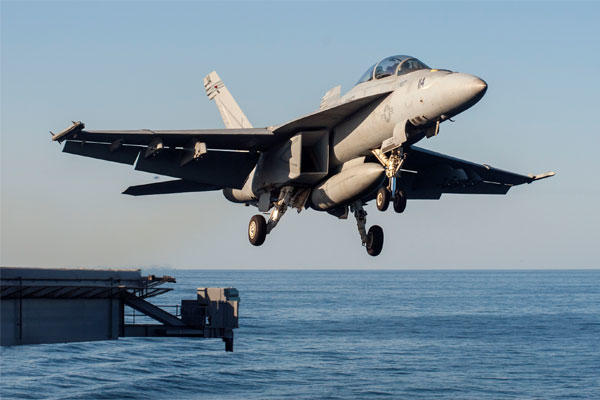The Navy's 2016 "wish list" for Congress includes requests to buy more F/A-18 Super Hornets and F-35 Joint Strike Fighters, according to a Reuters report.
The service plans to ask Congress for 12 F/A-18s and eight more F-35s when their annual "unfunded priorities" list makes it way over to lawmakers, the report says. The Navy's list prepared for Congress, which has been reviewed by senior service and Pentagon leaders, is slated to be sent to U.S. lawmakers in the next few days, Reuters reported.
Unfunded priorities lists are often weapons and equipment desired by the services that was not included in the service's 2016 defense budget request. Last year, for example, the Navy placed 22 E/A-18G Growler electronic jamming aircraft on the unfunded priorities list. Congress wound up funding as many as 15 of the 22 Growlers asked for by the Navy.
Navy officials told Military.com that the service's unfunded priorities list is not yet ready to be announced and is still being reviewed by service and Pentagon officials.
The addition of eight F-35s on the unfunded priorities list could help the Navy make up for some of the 16 carried-launched F-35Cs the service wound up cutting over a five year spending period stretching from 2015 through 2020.
"We cut 16 F-35Cs, even though they are our future. It takes me six to ten years to build a ship and it takes me two to three years to build an aircraft and takes me a year to build a weapon. If I want to build it quicker I will take risk in aviation and weapons. If I stop ships it is really going to cause a major hole in the Navy," said Vice Adm. Joseph Mulloy, Deputy Chief of Naval Operations, Capabilities and Resources.
If Congress allows the Navy to acquire 12 more F/A-18 Super Hornets – it will reverse the current plan to end F/A-18 production. In fact, the formal 2016 budget request includes no funding for F/A-18s as the service has been planning to phase out the production line by the end of 2017.
However, if more F/A-18s are purchased and the Navy opts to move forward with various proposed upgrades to the platform – then production at Boeing's St. Louis facility could extend well beyond 2017.
Also, the F/A-18 is the same platform used for the E/A-18G Growler – so extending production of F/A-18s could bring the possibility of adding more Growlers. The Navy has said it is not requesting additional Growlers, but an ongoing Pentagon assessment is investigating whether the Navy needs them.
In addition, the Navy is considering whether to implement a series of proposed Boeing upgrades to the F/A-18 platform – a move which could also extend the production line.
Boeing officials have said they will wind up needing to decide whether to extend production at their facilities before Navy and Congressional budget decisions about fleet numbers are finalized.
Some of the proposed alterations include the use of new external weapons' pods and conformal fuel tanks aerodynamically designed to carry up to 3,500 pound of fuel and help give the aircraft a lower radar signature. Boeing officials have said the conformal fuel tanks reduce the signature of the aircraft by over 50-percent, and help the aircraft fly further with more weapons.
The external weapons pod, as opposed to using pylons for weapons, could lead to greater use of air-to-air missiles as well as air-to-ground bombs. The enclosed, external aerodynamically engineered weapons pod is built to carry up to 2,500-pounds of weapons.
The Super Hornet is configured to fire AIM-9X sidewinder air-to-air missile, the AIM-120 Advanced Medium Range Air-to-Air Missile, or AMRAAM, the Joint Standoff Weapon, the Small Diameter Bomb and the Mk-84 general purpose bomb, among others.
These upgrades are needed because F/A-18 aircraft are expected to serve well into the 2030's, some Navy and Boeing officials said.
So far, the Navy, Boeing and its partners have built and delivered more than 487 F/A-18 E and F models on their way to a program goal of 563 aircraft, Navy officials said.
The current Block II configuration of the F/A-18 Super Hornet, which first deployed in 2008, was engineered with a host of signature-reducing and endurance enhancing modifications compared to prior models of the aircraft.
Some of the enhancements include the use of Active Electronically Scanned Array, or AESA, radar, "jamming" decoys and an integrated electronic countermeasures system. The countermeasures system consists of three main components; they include and on-board jammer, visually cued radar warning receiver and a decoy, according to Navy officials.
-- Kris Osborn can be reached at kris.osborn@military.com




























